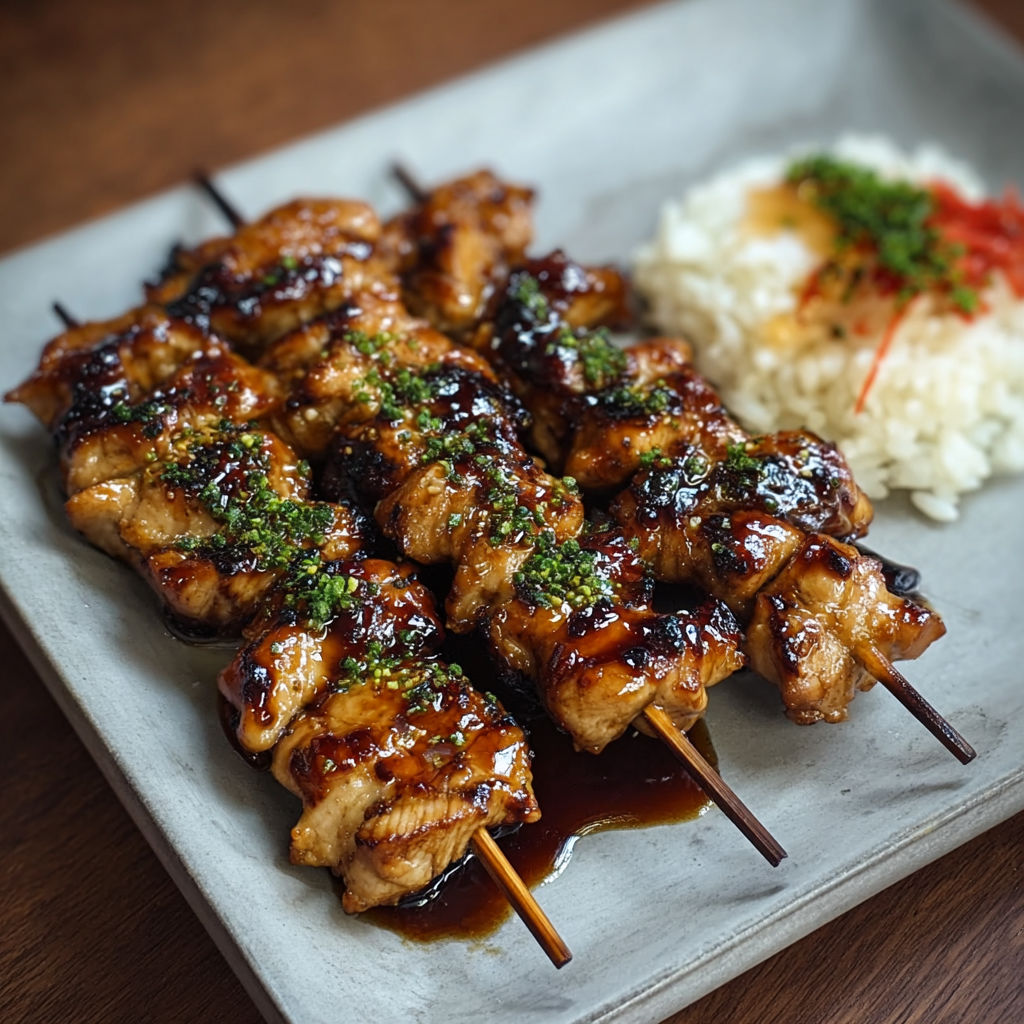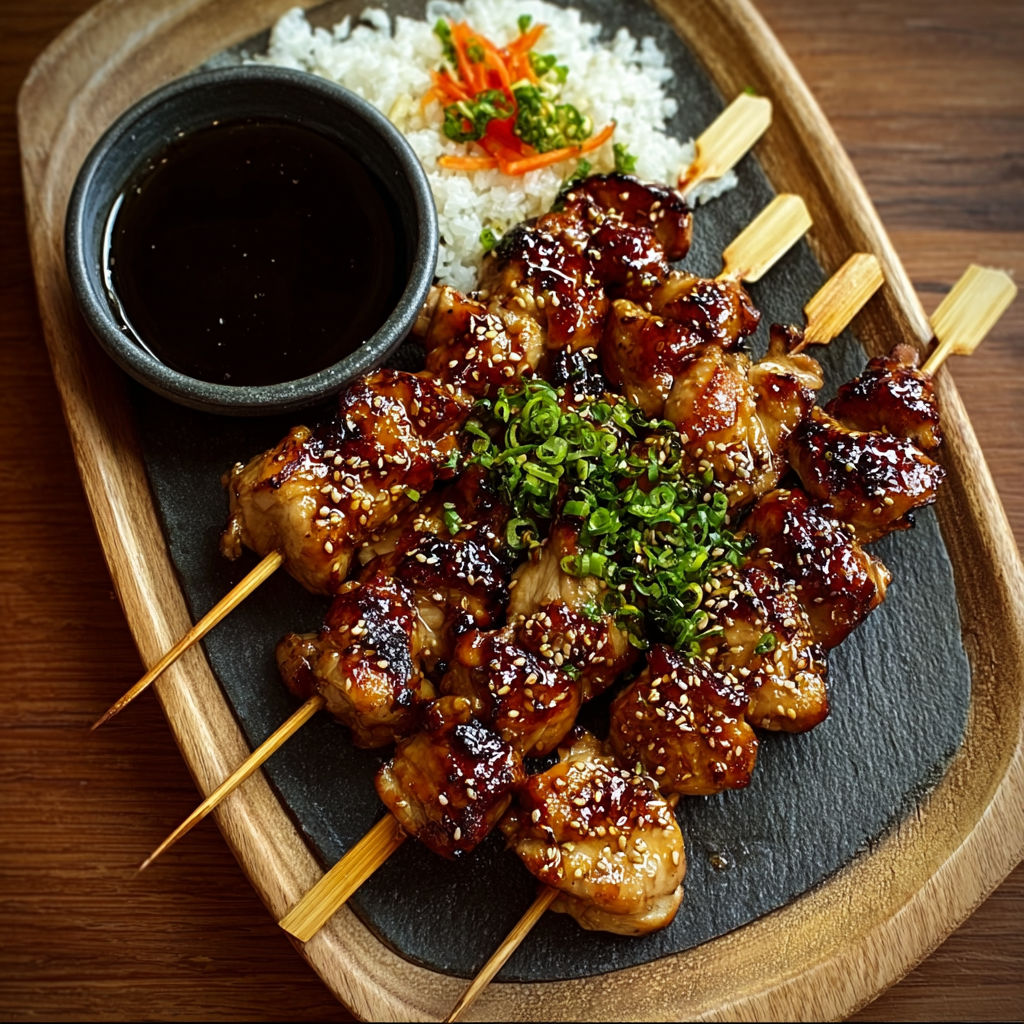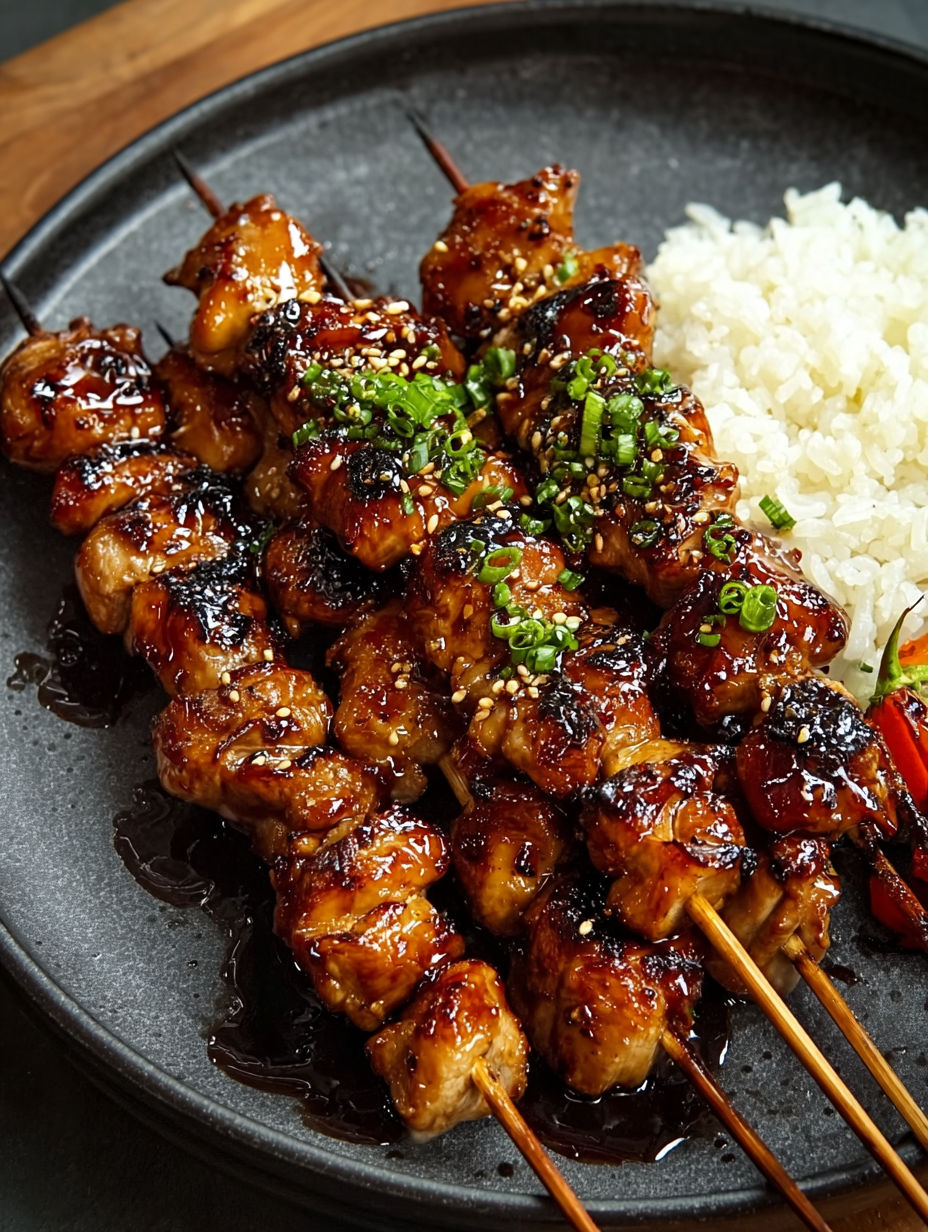 Pin it
Pin it
This homemade Japanese Chicken Yakitori turns basic ingredients into an amazing street food treat right in your kitchen. The sticky, sweet-salty glaze browns perfectly on juicy chicken thighs, giving you those signature charred bits you'd expect from authentic Japanese food stalls.
I started making this yakitori during my Japanese cooking obsession after my Tokyo trip. What began as just trying something new quickly turned into our end-of-week family tradition. These days my children grab the sticks straight from the grill before I've even got plates ready.
What You'll Need
- Bite-sized chunks of boneless chicken thighs. This darker meat stays moist when cooked over high heat.
- Soy sauce gives that key savory base to the sauce. Try to grab Japanese brands if you can find them.
- Mirin adds sweetness and makes the sauce shiny. Go for real mirin with alcohol for the best flavor.
- Sake brings extra flavor and softens the meat. Just regular cooking sake is fine.
- Sugar helps the sauce brown nicely and cuts the saltiness. You can swap in brown sugar too.
- Garlic and ginger create the flavor foundation. Don't use the dried stuff here.
- Bamboo sticks for that traditional look. Soak them first so they won't burn.
- Green onions add fresh color and taste when scattered on top before serving.
How To Cook Chicken Yakitori
- Mix up the sauce
- Put soy sauce, mirin, sake, sugar, minced garlic, and grated ginger in a small pot. Heat it until it starts bubbling, then turn down the heat right away. Let it cook slowly for 10 minutes, giving it a stir now and then until it gets thick enough to stick to a spoon. The smell gets better and better as it cooks down. Take it off the heat and let it cool a bit.
- Put chicken on sticks
- Push chicken bits onto your wet bamboo sticks, making sure not to pack them too tight. Keep one end empty so you have something to hold. Try to put similar-sized pieces together so everything cooks at the same rate.
- Get your grill ready
- Fire up your grill or heat a grill pan to pretty hot. This high heat will give you those nice grill marks while keeping the chicken juicy inside. Wipe some oil on the grates using a paper towel grabbed with tongs so the meat won't stick.
- Cook with the right method
- Put your chicken sticks on the hot grill and let them cook about 3-4 minutes each side until you see dark lines forming. In the last few minutes, start brushing lots of sauce on the chicken. Keep turning and adding more sauce for another 2-3 minutes until it looks shiny and has some dark spots.
- Add one last coat
- Just before taking them off, brush on plenty more sauce. The chicken should reach 165°F inside and look glossy with some charred edges.
When I first cooked this yakitori for my family, even my grandma who usually sticks to her favorite foods asked for more. She told me it reminded her of teriyaki chicken but with extra layers of flavor. Now I always make a bigger batch of sauce to keep in my fridge for quick dinners.
Prep Ahead Ideas
What's great about yakitori is how much you can do beforehand. You can make the sauce up to five days early and store it in a sealed container in your fridge. The flavor actually gets better over time as everything blends together. You can even put the chicken on skewers a day ahead and keep them covered in the fridge until cooking time. This makes yakitori perfect for parties when you don't want to spend all your time in the kitchen.
 Pin it
Pin it
How To Serve It
In Japan, people usually eat yakitori as part of a bigger meal with small dishes and cold drinks. For a real Japanese feel at home, put your chicken sticks on some thin-sliced cabbage that soaks up the dripping sauce. Serve with plain rice, some quick pickled veggies like cucumbers, and cold Japanese beer or chilled sake. Add a bowl of miso soup to make it a full meal. The mix of hot grilled meat with cold sides makes for a really balanced dinner.
Traditional Options
Real yakitori spots in Japan grill every chicken part imaginable, each with its own special taste. While thigh meat yakitori is what most non-Japanese folks know best, you can try it with chicken breast if you want something leaner. For the most authentic version, go for negima yakitori which puts pieces of chicken and chunks of green onion on the same skewer. Some Japanese cooks finish with a light sprinkle of shichimi togarashi spice mix for a mild kick that goes great with the sweet sauce.
 Pin it
Pin it
Frequently Asked Questions
- → Which part of the chicken is best for yakitori?
Boneless thighs are the top choice since they’re juicier and more flavorful than breasts. They stay tender while grilling and have a bit of fat that keeps them from drying out. If you need to use chicken breasts, just grill them a little less to avoid drying.
- → Can I cook yakitori without a grill?
Definitely! Use a stovetop grill pan or broil the skewers in the oven. Lay them on foil-lined baking sheets about six inches from the broiler, turning and brushing sauce as they cook. If you've got an electric grill, that'll also do the trick for a similar effect.
- → What can I use if I don’t have sake or mirin?
If sake's not available, swap it out for dry sherry or Shaoxing wine. For mirin, mix a tablespoon of rice vinegar with a teaspoon of sugar or use sweet marsala wine. If needed, a combo of three parts white wine to one part sugar works in a pinch for both substitutes.
- → How long do bamboo skewers need to soak?
Soaking bamboo skewers for 30 minutes stops them from charring. For more protection, aim for an hour. If your grill runs extra hot, try wrapping the exposed ends with foil to keep them intact.
- → What are good sides with yakitori?
Steamed rice, miso soup, or pickled veggies go hand-in-hand with yakitori. A light cucumber salad works great, too. For variety, pair it with other grilled options like tofu or veggies. Wash it down with a cold beer or some sake for a perfect pairing.
- → Can I prep the yakitori sauce in advance?
Absolutely! Make the tare a week before and store it sealed in the fridge. The flavor deepens with time. When it’s time to use, just reheat. Fun fact: Many Japanese restaurants keep adding to their batch over time for even richer flavors.
